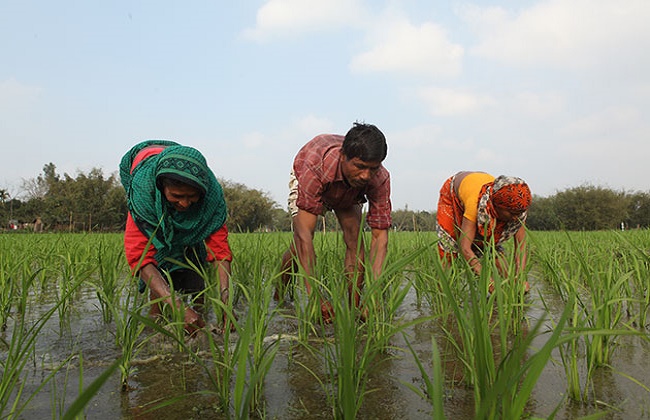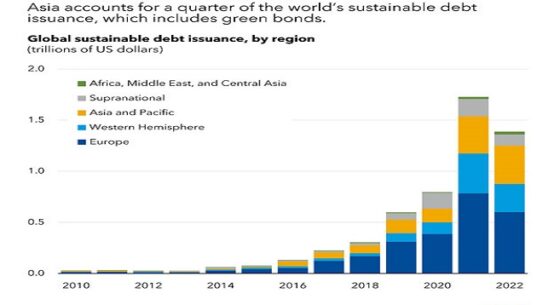
Half the world eats rice. In Bangladesh, everyone eats it. The small, densely-populated nation is the third-highest rice-producing country in the world.
For a nation of 170 million people which has suffered through some of the world’s worst famines, this ranking holds special significance. While Bangladesh is mostly self-sufficient in food now, its farmers face a new threat ¬– the climate crisis.
The impact of a changing climate on food security is a catastrophe shared by many countries in the Global South, from the Philippines, where biodiversity based rice farming is facing extinction, to Peru, where drought has devastated food systems.
Smallholder farmers produce one-third of the world’s food. In Bangladesh, agriculture makes up every second livelihood. The country has a population predicted to swell to 200 million people by 2050, and salinity intrusion is affecting an area larger than Lebanon.
In 2022 alone, flooding destroyed crops that would have been enough to feed 10 million people for a month. The impacts of Cyclone Sidr, which struck Bangladesh’s coast 16 years ago, are still felt today, with salt residue rendering thousands of hectares of land non-arable for much of every year.
Bangladesh is small – its land size is just a little more than the US state of Mississippi – but surprisingly diverse in terms of topography and ecosystems, and the climate crisis is a cruel reminder of that diversity.
North-eastern Bangladesh floods regularly, central regions suffer longer dry spells, coastal areas are under attack by rising salinity, and farming communities along Bangladesh’s 600-plus rivers are constantly threatened by erosion.
A whole-of-society approach
Climate impacts are attacking smallholder farmers on every front. To support them on every front, we can’t tinker around the edges; we need holistic solutions at scale.
Bangladesh is an example that these approaches work – it has used holistic, large-scale approaches to take poverty rates from 80% to 18.7%, increase life expectancy by one and a half times and triple rice production – all in the last 50 years.
Farmers in Bangladesh weeding their rice fields a month after planting seedlings. Bangladesh produced 38.3 million tonnes of rice in 2023. Credit: BRAC
The starting point for such an approach must be the most fundamental – seeds, which Bangladesh has invested in for decades. One of the key reasons the country was able to become self-sufficient in food was because of widespread uptake of high yield varieties.
It turns out, however, that high yield crops are particularly vulnerable to climate impacts. There is also a lack of diversity – while hundreds of climate-resilient varieties are available in Bangladesh, 70% of the country’s Boro rice fields are cultivated with just two varieties.
The work needed going forward is not only in the development of climate resilient seeds, but also in working with farmers to encourage them to use them, as well as to try different crops altogether.
Rice, for example, the mainstay of the Bangladeshi diet, which covers 80% of cultivable land in the country, needs 3,000-5,000 litres of water to produce 1kg. Maize requires 30% less, and millets require 70% less. Methane from rice also contributes around 1.5% of total global greenhouse gas emissions. With many smallholder farmers living harvest to harvest though, getting them to change varieties is not easy.
Non-government organizations can help address this issue, because they work closely with communities and are trusted by them. BRAC works with a network of 7,000 smallholder farmers to produce seeds which are distributed to a community of 1.3 million farmers – and networks and communities like this exist across the Global South.
Access to finance is vital
To experiment with seeds though, farmers need access to finance. Most Bangladeshi subsistence farmers earn less than $2 per day, making it a constant struggle to eke out a living, let alone to invest in their livelihood.
Farmers typically don’t need a lot of money – but they often need it all at once, at the start of the season. Customized microfinance loans for farmers are key in this. BRAC provides finance to approximately 10 million people, many of whom are farmers – and increasingly in the form of one-off loans to be repaid at harvest time. The default rate is less than 2%.
Crop insurance is also crucial, to support farmers to absorb increasing climate shocks. More than half the world’s countries have government agriculture insurance programmes, and most of those subsidize premiums.
Only four countries in Africa, however, have them. At BRAC, we recently piloted crop insurance, partnered with agri-advisories and localized weather predictions via SMS with 80,000 farmers. Even without subsidizing, more than half the farmers opted to continue the insurance after the pilot.
Importance of up-to-date knowledge for farmers
Farmers also need information at their fingertips, in a way they can understand. Government agricultural extension services provide this, and non-state actors can ensure it gets to particularly vulnerable communities.
One initiative being piloted in Bangladesh is adaptation clinics – one-stop service centres in climate hotspots run by agricultural graduates and farmers in those communities, offering other farmers access to a range of resources, from weather forecasts and market information to training, technology and produce storage facilities.
They also need to know they can sell their new produce. Sunflowers are a good example. Sunflower oil is used extensively in cooking in Bangladesh, and the country relies on imports to meet 90% of its demand for edible oil.
Sunflowers are also a naturally salt-tolerant crop. Even though the government put effort into promoting sunflowers for years, the crop was never taken up because of a lack of buyers.
Now with industrial oil producers showing interest and that market gap being addressed, there is a bloom of sunflower farming on the coast – and farmers are fetching up to five times as much as they would make from the crops they would previously have grown.
Challenges facing farmers only intensifying
Seeds, finance, information, and market linkage are just the start. With climate impacts anticipated to wipe out 30% of food production by 2050, the challenges farmers are facing are only going to intensify.
They need support which is equally comprehensive, that combines the technical strengths of state and private actors, with the confidence and localized direction on the ground from non-state actors to transition away from generations of tradition.
With a global population that is only getting hungrier ¬– 43 countries currently have alarming or serious levels of hunger – the stakes have never been higher.
This article was originally published in World Economic Forum Agenda blog which can be accessed through this link.
Asif Saleh is the Executive Director of BRAC


